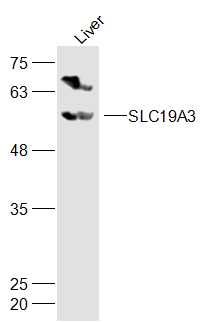产品货号 : mlR8702
英文名称 : SLC19A3
中文名称 : 溶质载体家族19成员3抗体
别 名 : Solute carrier family 19 member 3; Thiamine transporter 2; thTr 2; THTR2.
研究领域 : 细胞生物 神经生物学 信号转导 转运蛋白 跨膜蛋白
抗体来源 : Rabbit
克隆类型 : Polyclonal
交叉反应 : Human, Mouse, Rat,
产品应用 : WB=1:500-2000 ELISA=1:500-1000 IHC-P=1:400-800 IHC-F=1:400-800 ICC=1:100-500 IF=1:100-500 (石蜡切片需做抗原修复)
not yet tested in other applications.
optimal dilutions/concentrations should be determined by the end user.
分 子 量 : 56kDa
细胞定位 : 细胞膜
性 状 : Lyophilized or Liquid
浓 度 : 1mg/ml
免 疫 原 : KLH conjugated synthetic peptide derived from human SLC19A3:261-360/496 <Extracellular>
亚 型 : IgG
纯化方法 : affinity purified by Protein A
储 存 液 : Preservative: 15mM Sodium Azide, Constituents: 1% BSA, 0.01M PBS, pH 7.4
保存条件 : Store at -20 °C for one year. Avoid repeated freeze/thaw cycles. The lyophilized antibody is stable at room temperature for at least one month and for greater than a year when kept at -20°C. When reconstituted in sterile pH 7.4 0.01M PBS or diluent of antibody the antibody is stable for at least two weeks at 2-4 °C.
PubMed : PubMed
产品介绍background:
This gene encodes a ubiquitously expressed transmembrane thiamine transporter that lacks folate transport activity. Mutations in this gene cause biotin-responsive basal ganglia disease (BBGD); a recessive disorder manifested in childhood that progresses to chronic encephalopathy, dystonia, quadriparesis, and death if untreated. Patients with BBGD have bilateral necrosis in the head of the caudate nucleus and in the putamen. Administration of high doses of biotin in the early progression of the disorder eliminates pathological symptoms while delayed treatment results in residual paraparesis, mild mental retardation, or dystonia. Administration of thiamine is ineffective in the treatment of this disorder. Experiments have failed to show that this protein can transport biotin. Mutations in this gene also cause a Wernicke's-like encephalopathy.[provided by RefSeq, Jan 2010]
Function:
Mediates high affinity thiamine uptake, propably via a proton anti-port mechanism. Has no folate transport activity.
Subcellular Location:
Plasma membrane.
Tissue Specificity:
Widely expressed but most abundant in placenta, kidney and liver.
DISEASE:
The disease is caused by mutations affecting the gene represented in this entry.
Disease description:An autosomal recessive metabolic disorder characterized by episodic encephalopathy, often triggered by febrile illness, presenting as confusion, seizures, external ophthalmoplegia, dysphagia, and sometimes coma and death. If untreated, encephalopathies can result in permanent dystonia. Brain imaging may show characteristic bilateral lesions of the basal ganglia.
Similarity:
Belongs to the reduced folate carrier (RFC) transporter (TC 2.A.48) family.
SWISS:
Q9BZV2
Gene ID:
80704
Important Note:
This product as supplied is intended for research use only, not for use in human, therapeutic or diagnostic applications.
产品图片












